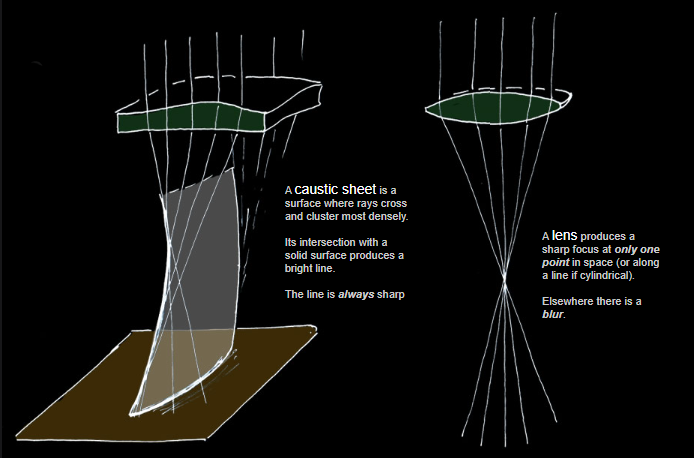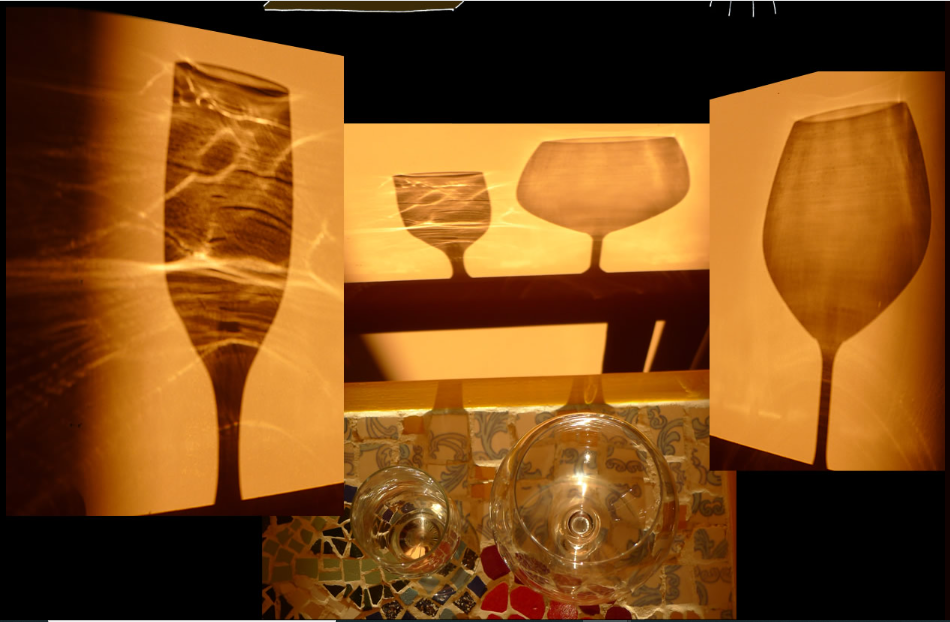Rippled glass caustics - OPOD
Rippled Glass Caustics: Exploring the Fascinating Interplay of Light and Surfaces
When it comes to atmospheric optics, one phenomenon that captivates our attention is the mesmerizing dance of caustics on various surfaces. Caustics occur when rays of light intersect and converge, creating regions of intense brightness. In this article, we delve into the captivating world of rippled glass caustics and their unique properties.
The Allure of Rippled Glass
Let's start by examining the peculiar characteristics of rippled glass. Imagine two glasses side by side: a smooth lead crystal on the right and a soda glass on the left. While the lead crystal boasts a sleek and uniform appearance, the soda glass stands out with its uneven cross-section. This irregularity plays a key role in enhancing its charm. As sunlight penetrates the glass during the late afternoon, the refracted rays create captivating caustic patterns on nearby walls.
These patterns bear resemblance to the shimmering ripples found in stream beds, shallow seas, and even swimming pools. They evoke a sense of frozen motion, capturing our imagination with their immobile beauty. Thanks to the lens-like properties of rippled glass, we can witness nature's artistic playfulness in our everyday surroundings.
The Intricacies of Caustics
Caustics, as we mentioned earlier, are areas in space where rays of light intersect, cluster, and intensify. In classical physics, these intersections would result in infinite intensity, but wave diffraction prevents this infinite escalation. Mathematically speaking, caustics represent spatial discontinuities, causing rays to behave differently on each side of the surface or sheet.
The study of catastrophe theory offers valuable insights into the structure and order of caustics. It helps us understand the mesmerizing patterns we observe on stream beds, boat hulls, and swimming pool floors. When a caustic surface encounters a solid object, a sharp and luminous line emerges. This line remains impeccably defined wherever the caustic sheet becomes visible.
The Limited Focus of Lenses
Comparatively, our meticulously crafted lenses pale in comparison to the intricate world of caustics. While lenses can focus rays at a single point or line in space, they fail to capture the intricate interplay of light that caustics effortlessly achieve. As we move away from the focal point, lenses introduce increasing blur, losing the crispness and intensity that caustics inherently possess.
The contrast between the precision of lenses and the captivating chaos of caustics highlights the unique beauty found in natural phenomena. Rippled glass caustics offer us a glimpse into the intricate workings of light, surfaces, and their harmonious dance.
Embracing the Enchantment
As we marvel at the enchanting patterns created by rippled glass caustics, it's important to appreciate the interplay of light and surfaces that brings them to life. Whether it's the delicate shimmer on a stream bed or the sparkling reflections on a swimming pool floor, these phenomena remind us of the hidden complexities that surround us.
By immersing ourselves in the world of atmospheric optics, we can uncover new wonders and deepen our understanding of the natural world. The captivating allure of rippled glass caustics serves as a testament to the vastness of nature's artistry and the limitless potential for discovery that awaits us.
So next time you encounter rippled glass, take a moment to appreciate the intricate patterns it creates. Let yourself be drawn into the dance of light and surfaces, and allow the enchantment of rippled glass caustics to captivate your imagination.

Caustics & Lenses
Two glasses, at right a smooth lead crystal and at left a soda glass.
The higher temperature softening point soda glass has an uneven cross section that adds to its charm. The irregularities refract the rays of the late afternoon sun to produce bright caustic patterns on the wall. The patterns are those dancing on stream beds, in shallow seas and in swimming pools and twinkling stars but here they are frozen, immobile.
Images by Mario Frietas (site) of Universidade Tecnológica Federal do Paraná, Brazil.
All images ©Mario Frietas, shown with permission

Caustics versus Lenses
Caustics are surfaces in space where rays cross one another and cluster and coalesce together to give a high light intensity. In classical physics the intensity would be infinite but wave diffraction avoids this embarrassment.
Mathematically a caustic is more, it is a spatial discontinuity and rays behave differently on each side of the surface or sheet. Catastrophe theory has much to say about the structure and order of caustics that we sense in the shifting patterns on a stream bed, a boat hull or swimming pool floor.
Where the caustic surface reaches a solid surface we see a sharp bright line. It is always sharp wherever the caustic sheet is made visible.
In comparison our carefully crafted lenses are poor things. At best they focus rays at only a single point (or line) in space. Move away from the focus and there is an increasing blur.

Note: this article has been automatically converted from the old site and may not appear as intended. You can find the original article here.
Reference Atmospheric Optics
If you use any of the definitions, information, or data presented on Atmospheric Optics, please copy the link or reference below to properly credit us as the reference source. Thank you!
-
<a href="https://atoptics.co.uk/blog/rippled-glass-caustics-opod/">Rippled glass caustics - OPOD</a>
-
"Rippled glass caustics - OPOD". Atmospheric Optics. Accessed on November 26, 2024. https://atoptics.co.uk/blog/rippled-glass-caustics-opod/.
-
"Rippled glass caustics - OPOD". Atmospheric Optics, https://atoptics.co.uk/blog/rippled-glass-caustics-opod/. Accessed 26 November, 2024
-
Rippled glass caustics - OPOD. Atmospheric Optics. Retrieved from https://atoptics.co.uk/blog/rippled-glass-caustics-opod/.